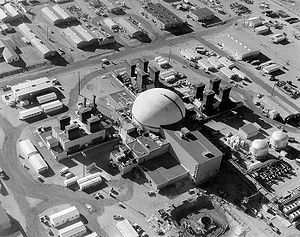Fast Flux Test Facility
| Fast Flux Test Facility | ||
|---|---|---|

Aerial view of the Fast Flux Test Facility |
||
| location | ||
|
|
||
| Coordinates | 46 ° 26 '7 " N , 119 ° 21' 32" W | |
| country |
|
|
| Data | ||
| owner | US Department of Energy | |
| operator | Westinghouse Electric Corporation | |
| start of building | 1st January 1969 | |
| Installation | February 9, 1980 | |
| Shutdown | March 18, 1992 | |
| Reactor type | Liquid metal-cooled fast breeder reactor | |
| Thermal performance | 400 MW | |
| Neutron flux density | 4.6 × 10 15 n / (cm 2 s) | |
| was standing | February 2, 2009 | |
The Fast Flux Test Facility (abbreviation FFTF ) was an experimental breeder reactor at the Hanford Site in Benton County in Washington State in the United States .
The reactor
It is a liquid metal-cooled fast breeder reactor with a thermal output of 400 megawatts. The FFTF was the world's largest test reactor of its kind. Sodium was used as the coolant . The fuel rod cladding tubes were made of Type 316 stainless steel.
The reactor belongs to the US Department of Energy (DOE) and was decommissioned in 1992.
Purpose and use
The reactor was a prototype for the US breeder reactor program. It was primarily intended for testing fuels and materials. It was also used as a neutron source and as a material test reactor . During its 10 years of successful operation, the FFTF conducted a variety of research and testing programs for nuclear fuels, materials and systems. Some of these experiments were done for other countries, including Japan and Canada. The FFTF also produced medical radionuclides for cancer treatment, including gadolinium-153 and cobalt-60, and tritium .
history
Planning for the FFTF began in 1965, during the heyday of nuclear experiments in the United States. The conception was completed four years later. In 1970 Westinghouse was selected to build and operate the facility. Construction was completed in 1980 and operations began in the late summer of 1982. Several hundred people were employed in the plant.
The reactor first became critical in 1980 and was briefly threatened with decommissioning until the US government recognized a great advantage in continuing to operate the plant. In 1992 the reactor was shut down.
Until 2002, the reactor was in "hot standby" status, which cost 31 million US dollars a year. Then, however, the dismantling of the FFTF started because the George W. Bush administration had no use for the research reactor.
Web links
- John Reese: Stop the Fast Flux Test Facility at Hanford! Independent Media Center (IMC) August 19, 2000, archived from the original January 17, 2012 ; accessed on July 11, 2016 (English, view of the FFTF opponents).
Individual evidence
- ↑ Fast Flux Test Facility, WA (English)
- ↑ a b c IMINT / DOE - Hanford Site (English)
- ↑ Fast Flux Test Facility Instrumentation Requirements (English)
- ↑ a b Fast Flux Test Facility. Department of Energy - Richland Operations Office, archived from the original on August 27, 2009 ; accessed on July 11, 2016 .
- ↑ a b c 400 Area: Fast Flux Test Facility. Department of Energy - Hanford Site, archived from the original on September 17, 2008 ; accessed on July 11, 2016 .
- ↑ a b Theoretical Analysis of Sodium Removal from Fast Flux Test Facility Fuel Subassemblies (English)
- ↑ AL Pitner, BC Gneiting, RB Baker, SL Hecht: Prototype oxide breeder tests in the Fast Flux Test Facility . In: Nuclear Technology (United States) . tape 105 , no. 3 , 1994, ISSN 0029-5450 , pp. 355-365 .
- ↑ Fast Flux Test Facility (English)
- ↑ Dismantling of Hanford's Fast Flux Test Facility starts today , message from September 19, 2002 (English)


